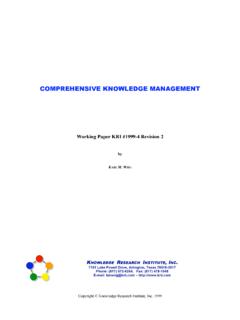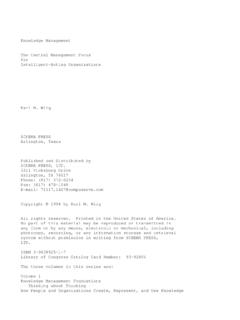Transcription of Knowledge Management Glossary - Home | …
1 1 Knowledge Management GlossaryKnowledge Research Institute, Inc. and Other reasoning : A special case of inductive reasoning resulting in specific assertions that imply theavailable information in context of the background Knowledge without logical certainty. Example: Premise:"Those dogs are mastiffs." Background Knowledge : "All Erik's dogs are Mastiffs." Hypothesis: "Perhaps thosedogs are Erik's."Acquisition: (Also see Knowledge Acquisition) Knowledge may be acquired and represented for inclusion in aknowledge model. Acquisition can be performed by eliciting Knowledge from a domain expert, inducingknowledge from examples, porting Knowledge from databases, and by other Space: The realm, the space, within which a person or enterprise is competent, willing,comfortable or otherwise prepared to make decisions and act. The Action Space is not a passive domain withfixed boundaries. It is formed by the creative capabilities, methodologies and attitudes, mentalities andmotivations that allow actors to perform regular tasks and consider novel actions and innovate within theboundaries of what they find to be permissible and acceptable and is closely related to what is considered tobe : An agent that perform actions predominantly a person but can be an organizational entity or acomputer programmed to handle learning: See: Single-Loop LearningAdjacent Function: A business function that exchanges (provides or receives) consultation or collaborationresources, information, or secondary work products with the target action review: A process developed by the US Army to help teams to learn quickly from their successesand failures and share their learning with other teams.
2 Involves conducting a structured and facilitateddiscussion after a task or project has been completed to review what should have happened, what actuallyhappened and why it happened; this allows participants to learn how to sustain strengths and improve onweaknesses in subsequent tasks or Technologist: A professional with good applied Knowledge of basic AI techniques and selected tools usedin the professional's environment. AI technologists are capable encoders of Knowledge from codifiedknowledge and may be proficient AI Intelligence (AI): AI is sub field of computer science concerned with pursuing the possibility that acomputer can be made to behave in ways that humans recognize as 'intelligent' behavior in each AI becomes a broader field than AI, including cognitive, social and Management intelligence: A broad term describing the field of developing computer programs to simulate humanthought processes and Management Mentality: Management attitude and practice required manage intangible assets with thesame objectives as for tangible assets.
3 The mentality to focus on operational and strategic objectives to create,renew and maintain, safeguard, and utilize and leverage Intangible Capital throughout the Knowledge : Explicit Knowledge that has been embedded in an automatic device (such as acomputer).Automatic Knowledge : The lowest abstraction level of conceptual Knowledge , where we hold RoutineWorking Knowledge . We know this Knowledge so well that we have automated it. Most has become tacit --we use it to perform tasks automatically -- without conscious or Automatized Knowledge : The lowest abstraction level of tacit Knowledge . People know thisknowledge so well that it has been automated and is used to perform tasks automatically -- without : A (computerized) search technique used in production ( , "if-then" rule) with the action clause of a rule and works backward through a chain of rules in an attempt to find averifiable set of condition clauses. (Also termed "goal-oriented reasoning " or "top-down search.)
4 ") Inferenceengines backward-chain from one if-then rule to other rules in the Knowledge base to find new valuesneeded to test if-conditions stated in the scorecard: A business model developed by Kaplan and Norton as a tool to measure organizationalperformance against both short and long-term goals. The balanced scorecard is designed to focus managers'attention on those factors that most help the business strategy and so alongside financial measures, it addsmeasures for customers, internal processes and employee learning. Some organizations have used thebalanced scorecard model in setting and measuring Knowledge Management Knowledge Analysis (BKA): A relatively extensive analysis and characterization of the Knowledge inthe task environment. It focuses on how Knowledge is held, used, etc., and encompasses Task EnvironmentAnalysis (TEA), Critical Knowledge Function Analysis (CKFA), business function analysis, and knowledgeacquisition -- or Knowledge elicitation and : The practice of comparing the performance of your organization, department or functionagainst the performance of 'the best' - whether they be other organizations, industry standards or internaldepartments.
5 The aim is to look at how well you are doing compared to others in the same field or industry,and to learn from their best practices as a basis for improving your practice (or: Good practice): A process or methodology that has been proven to work well and producegood results, and is therefore recommended as a model. Some people prefer to use the term 'good practice' asin reality it is debatable whether there is a single 'best' Systems: Knowledge -based systems that consist of several separate reasoning processes that use a"blackboard" to "post" intermediate results or information that needs to be communicated between the varioussystems. Blackboard systems may be used for multiple-hypothesis : See: Web BrowserCCapacity building: A term sometimes used in Knowledge Management to describe the process of enhancing anorganization s ability to implement Knowledge Management principles and Learning: Approach to learning using cases (stories, scenarios, descriptions of real events, etc.)
6 To illustrate the material to be internalized. Case-based learning is supportive of building mental reasoning (CBR): reasoning approach often used by people but also implemented as KBSreasoning strategy. In case-based reasoning we compare the present situation or condition to previouslyexperienced situations (reference cases) and interpolate between the most likely ones to arrive at conclusionsfor how to handle the present : See Computer-Based Factor: Either a number supplied by an expert system to indicate the system's level of confidence inthe conclusion, or a number supplied by the user of an expert system to indicate the user's level of confidencein the validity of the information supplied to the : A person who proactively promotes something with the aim of persuading others of its Information Officer (CIO): A senior position with strategic responsibility for information managementand information Knowledge Officer (CKO): A senior position with strategic responsibility for Knowledge : A mental activity that allows aggregating several (typically five to nine) entities such as conceptsinto a single, new.
7 See Chief Information OfficerCKF: See Critical Knowledge : Critical Knowledge Function : See Chief Knowledge OfficerClosed System: A system-theoretic concept A system that is isolated from its environment such that its finalstate is determined by its initial Many physical systems are examples of closed systems which inaddition have manipulated and observable input variables that will change their states. The states of suchclosed systems are observable. Hence they are identifiable and controllable in contrast to open : A one-to-one relationship that aims to bring about individual learning and performanceimprovement, usually focusing on achieving predefined objectives within a specific time period. The role ofthe coach is to create a supportive environment in which to challenge and develop the critical thinking skills,ideas and behaviors of the person being coached, so that they might reach their full potential. Related : Knowledge codification deals with obtaining, characterizing, and validating Knowledge .
8 Itincludes of elicitation or acquisition, analysis, and synthesis (rational reconstruction) of Knowledge togenerate internally consistent Knowledge models that are congruent with domain Knowledge as held byexperts or existing as previously codified bodies of Knowledge . The process of getting people's knowledgeinto a form by which it can be communicated independently of those people. The most common method iswriting things down and putting them into documents and databases. Other methods include pictures, andsound and video recordings. Related term: Knowledge HarvestingCognition: The act or process of knowing (Webster, 1986).Cognitive Engineering: A recently coined term to denote the professional field concerned with analysis andsynthesis of systems which interact with human cognitive functions. Cognitive engineering encompasses:Human behavior in the real target world; ecological aspects of that world; semantic contents of the targetdomain; behavior and performance; and implications of changing cognitive-related aspects of the Science: The field which investigates the details of the mechanisms and processes of humanintelligence (such as learning, memory, recall, decision making) to determine the procedures and functionswhich produces and utilizes that Style: An individual s mental approach and reasoning style.
9 Cognitive styles include preferences forgraphic or verbal representations of concepts, hemispheric dominance, and so , Collaborative working: A generic term that simply means teamwork or a group effort. It alsohas a more specific meaning in Knowledge Management , where it is often used to describe close workingrelationships involving the sharing of of interest (CoI): Networks of people who share a common interest in a particular topic, eitherwork-related or peripheral to work, and who come together informally to share Knowledge on that term: Communities of of practice (CoP): Networks of people who work on similar processes or in similar disciplines,and who come together to develop and share their Knowledge in that field for the benefit of both themselvesand their organization(s). They may be created formally or informally, and they can interact online or : The capacity and capability of a person or other actor to function with a desired effectiveness the ability to deliver quality work within a particular advantage: A widely-used term in the private sector to describe something that differentiates acompany from its competitors in the same industry and makes it more likely to gain profits than the Staff Work: The study of a problem and presentation of a solution, with alternatives, to a manager,so that all that remains to be done by the manager is to indicate approval or disapproval of the Training (CBT): Training program delivered by interactive computers.
10 Modern CBTsinclude multimedia (sounds, video clips) hyper-links, and may also have embedded intelligence to guide orchallenge students. Some CBTs allow students to react to simulated real-life situations (such as beingconfronted by angry customer) and will record student s behavior as computer changes the path of Hierarchy: A hierarchy of related concepts, particularly as they relate to a particular position, role,task, or activity. Concept hierarchies build on concepts that are consolidated through chunking and are relatedto semantic nets and Knowledge Net: A net(work) of related concepts, often pertaining to particular situation. The connectionsbetween concept nodes may be specified as to relation : An abstract or general idea often generalized from specific instances. A concept can be a mentalmodel and be tied to other concepts through Blending: The human capability to integrate and find new meaning in large amounts of knowledgecoming from different sources and that may be semantically distant from one Knowledge : Abstract mental models of the world.









